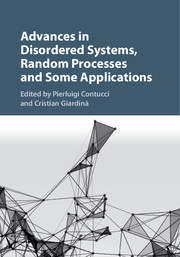Book contents
- Frontmatter
- Contents
- List of Contributors
- Preface
- 1 Topological Field Theory of Data: Mining Data Beyond Complex Networks
- 2 A Random Walk in Diffusion Phenomena and Statistical Mechanics
- 3 Legendre Structures in Statistical Mechanics for Ordered and Disordered Systems
- 4 Extrema of Log-correlated Random Variables: Principles and Examples
- 5 Scaling Limits, Brownian Loops, and Conformal Fields
- 6 The Brownian Web, the Brownian Net, and their Universality
- Index
5 - Scaling Limits, Brownian Loops, and Conformal Fields
Published online by Cambridge University Press: 19 January 2017
- Frontmatter
- Contents
- List of Contributors
- Preface
- 1 Topological Field Theory of Data: Mining Data Beyond Complex Networks
- 2 A Random Walk in Diffusion Phenomena and Statistical Mechanics
- 3 Legendre Structures in Statistical Mechanics for Ordered and Disordered Systems
- 4 Extrema of Log-correlated Random Variables: Principles and Examples
- 5 Scaling Limits, Brownian Loops, and Conformal Fields
- 6 The Brownian Web, the Brownian Net, and their Universality
- Index
Summary
Introduction
Critical Scaling Limits
One of the main goals of both probability theory and statistical physics is to understand and describe the behavior of random systems consisting of a very large number of components (atoms, molecules, pixels, individuals, etc.) where the effect of each single component is negligible and the behavior of the system as a whole is determined by the combined effect of all its components. One usually wishes to study the behavior of such systems via some observables, suitably defined quantities that can be of an analytic or geometric nature. The asymptotic (in the number of system components) behavior of these quantities is often deterministic, but in some interesting cases it turns out to be random. This type of macroscopic randomness can be observed in critical systems, i.e., systems at a continuous phase transition point (the critical point).
In the physical theory of critical systems, it is usually assumed that, when a system approaches the critical point, it is characterized by a single length scale (the correlation length) in terms of which all other lengths should be measured. When combined with the experimental observation that the correlation length diverges at the critical point, this simple but strong assumption, known as the scaling hypothesis, leads to the belief that a critical system has no characteristic length, and is therefore invariant under scale transformations. This implies that all thermodynamic functions at criticality are homogeneous functions, and predicts the appearance of power laws.
It also suggests that, for models of critical systems realized on a lattice, one can attempt to take a continuum scaling limit in which the mesh of the lattice is sent to zero while focus is kept on macroscopic observables that capture the large scale behavior. In the limit, the discrete model should converge to a continuum one that encodes the large scale properties of the original model, containing at the same time more symmetry.
- Type
- Chapter
- Information
- Publisher: Cambridge University PressPrint publication year: 2016
- 8
- Cited by

